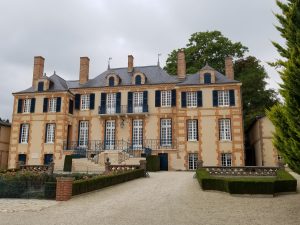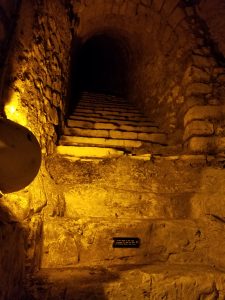At the end of a long boulevard in Reims sits the Taittinger headquarters. It sits on the site of a former Abbey of St. Nicaise that was destroyed by some zealots during the French Revolution. Nothing remains of the Abbey, or at least not above-ground. The ancient monks were winemakers themselves and they dug their cellars below their Abbey’s grounds, utilizing in part cellars created in the Fourth Century by the Romans, who were quarrying stone for buildings in the town. So while all cellar tours are pretty much the same, a visit to Taittinger has quite a lot of history to it.
Stairs used by the monks of St. Nicaise to enter the cellars
Taittinger is one of Champagne’s largest houses, based on the number of cases produced. Their wines are noted for their elegance and floral notes. It is also the parent company of California’s Domaine Carneros. Although anyone can reserve a tour and tasting, we used our membership in Domaine Carneros to obtain a private one.
Note that this storage cave contains 99,000 bottles of Comtes de Champagne
Today, the cellars in Reims are used solely to mature their top Champagne, the Comtes de Champagne. Deep below ground (18 meters or nearly 56 feet) you will see stack after stack of bottles that they age for at least 10 years. It is quite imposing.
But there are some things that you will not see. For one, you won’t see the facilities for storing their other Champagnes, such as their Brut Reserve or their rosé. For another, you won’t see the location where they actually crush the grapes and vinify their wines. And you won’t see the Château de la Marquetterie that appears on their bottles, just as the Domaine Carneros winery appears on the labels of the American sparkling wines. The château is actually in a small village called Pierry. You cannot visit it, but you can look at it.

Château de la Marquetterie in Pierry
What you can see in the caves in Reims is a lot of history. It does look yellow, because they use sodium lights to do the minimum damage to the Champagne. You see stairways that the monks used to descend into the cellars. You see beehive shaped vaults where the Romans excavated stone. And you see the convocation area where the monks gathered centuries ago.
After touring you do get a chance to taste the Champagne. The least expensive tour gets you a glass of the Brut Reserve, while the top-priced tour includes that wine plus the Comtes de Champagne, both white and pink.
Every trip to Champagne should include a visit to one of Grandes Marques, of which Taittinger is one of the leaders. Alas, some of these are rather industrialized; the historical interest of the Taittinger caves gives you a reason to choose this one.
Oh, and by the way, Americans. It’s not pronounced TAT-in-jer. You should say tet-ahn-ZHAY. It’s good to know if you go.

